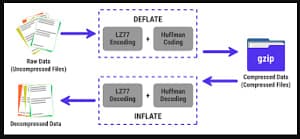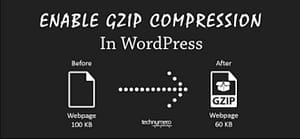Gzip Compression: How To Optimize Your Website
Gzip Compression: How To Optimize Your Website – Compression is a simple, powerful manner to shop bandwidth and accelerate your web page. I hesitated whilst recommending gzip compression whilst dashing up your javascript due to troubles in older browsers.
But it’s the twenty-first century. Most of my site visitors come from current browsers, and pretty frankly, a maximum of my customers are pretty tech-savvy. I don’t need to gradual every person else down due to the fact that someone is chugging alongside IE 4.0 on Windows 95.
Google and Yahoo use gzip compression. A current browser is wanted to revel in current internet content material and current internet speed — so gzip encoding it is. Here’s the way to set it up.
What is Gzip Compression

Gzip is a report layout and software program utility used on Unix and Unix-like structures to compress HTTP content material earlier than it’s served to a client.
The method has been regarded to decrease a report with the aid of using as much as eighty per cent, ensuing in stepped forward web page load time, reduced bandwidth intake and decreased SSL overhead (because of a lower withinside the wide variety of roundtrips all through an SSL handshake).
File kinds related to gzip encompass:
- .gz – Indicates a report extension compressed with the aid of using the gzip algorithm.
- .tar report, tarball – A layout used to save a couple of documents for archiving, however now no longer for compression. Gzip may be used to compress .tar documents.
- .tgz, .tar.gz, .gz report – Indicates a .tar report that’s been compressed with the aid of using gzip.
Enabling the Gzip Command

Gzip may be implemented to some unique platforms, inclusive of the ones special below:
WordPress
You can allow gzipping on WordPress with the aid of using the use of a caching plugin that helps gzip, or with the aid of using allowing gzip to your internet server through the .htaccess report.
Apache
To allow gzip on an Apache internet server, upload the gzip compression instructions in the mod_deflate module on the quit of the .htaccess report.
For example:
# Compress HTML, CSS, JavaScript, Text, XML and fonts
AddOutputFilterByType DEFLATE utility/javascript
AddOutputFilterByType DEFLATE utility/rss+xml
AddOutputFilterByType DEFLATE utility/vnd.ms-fontobject
AddOutputFilterByType DEFLATE utility/x-font
AddOutputFilterByType DEFLATE utility/x-font-opentype
AddOutputFilterByType DEFLATE utility/x-font-otf
AddOutputFilterByType DEFLATE utility/x-font-truetype
AddOutputFilterByType DEFLATE utility/x-font-ttf
AddOutputFilterByType DEFLATE utility/x-javascript
AddOutputFilterByType DEFLATE utility/xhtml+xml
AddOutputFilterByType DEFLATE utility/xml
AddOutputFilterByType DEFLATE font/opentype
AddOutputFilterByType DEFLATE font/otf
AddOutputFilterByType DEFLATE font/ttf
AddOutputFilterByType DEFLATE image/svg+xml
AddOutputFilterByType DEFLATE image/x-icon
AddOutputFilterByType DEFLATE text/css
AddOutputFilterByType DEFLATE text/html
AddOutputFilterByType DEFLATE text/javascript
AddOutputFilterByType DEFLATE text/undeniable
AddOutputFilterByType DEFLATE text/xml
NGINX
To allow gzip on NGINX, the subsequent code should be brought to the nginx.conf report:
gzip on;
gzip_disable “MSIE [1-6].(?!.*SV1)”;
gzip_vary on;
gzip_types text/undeniable text/css text/javascript image/svg+xml image/x-icon utility/javascript utility/x-javascript;
Verifying Gzip Activation
After allowing gzip, the subsequent step is to confirm that it’s compressing your outbound documents. This is accomplished both with the aid of using the use of any wide variety of online tools or with the aid of using checking HTTP reaction headers in a browser, e.g., with the aid of using ensuring that withinside the Network > Headers tab in Google Chrome, Gzip is displayed below the Content-Encoding header.
Additionally, it’s feasible to test HTTP reaction headers with the use of cURL, with the aid of using coming into withinside the following command:
curl -H “Accept-Encoding: gzip” -I https://sitename.com
In the reaction, gzip have to be indexed withinside the Content-Encoding header:
HTTP/1.1 2 hundred OK
Server: nginx
Date: Mon, 21 Jul 2014 01:12:36 GMT
Content-Type: text/html; charset=UTF-8…
Vary: Accept-Encoding
Content-Encoding: gzip
Once you’ve configured your server, take a look to ensure you’re sincerely serving up compressed content material.
Online: Use the web gzip check to test whether or not your web page is compressed.
In your browser: In Chrome, open the Developer Tools > Network Tab (Firefox/IE may be similar). Refresh your web page, and click on the community line for the web page itself (i.e., www.google.com). In the header “Content-encoding: gzip” approach the contents have been despatched compressed.
Click the “Use massive rows” icon to get extra details, inclusive of the compressed switch length and the genuine content material length.
Be organized to surprise by the results. The instacalc homepage was reduced in size from 36k to 10k, a 75% discount in length.
Try Some Examples
I’ve installed a few pages and a downloadable example:
- index.html – No specific compression (in this server, I am the use of compression with the aid of using the default).
- index.htm – Explicitly compressed with Apache .htaccess the use of *.htm as a rule
- index.personal home page – Explicitly compressed the use of the PHP header
Feel unfastened to download the documents, placed them on your server and tweak the settings.
How To Optimize Your Website
Before we begin I have to provide an explanation of what content material encoding is. When you request a report like http://www.yahoo.com/index.html, your browser talks to an internet server. The communication is going a touch like this:
Browser: Hey, GET me /index.html
Server: Ok, permit me to see if index.html is mendacity around…
Server: Found it! Here’s your reaction code (2 hundred OK) and I’m sending the report.
Browser: 100KB? Ouch… waiting, waiting… adequate, it’s loaded.
Of course, the real headers and protocols are plenty extra formal (screen them with Live HTTP Headers if you’re so inclined).
But it worked, and you acquire your report.
So what’s the problem?
Well, the machine works, however, it’s now no longer that efficient. 100KB is lots of text, and frankly, HTML is redundant. Every, and the tag has the last tag that’s nearly the same. Words are repeated for the duration of the document. Any manner you slice it, HTML (and its beefy cousin, XML) isn’t lean.
And what’s the plan whilst a report’s too huge? Zip it!
If we should ship a .zip report to the browser (index.html.zip) rather than undeniable antique index.html, we’d shop on bandwidth and download time. The browser should download the zipped report, and extract it, after which display it to the consumer, who’s in an excellent temper due to the fact the web page loaded quickly. The browser-server communication may appear like this:
Browser: Hey, can I GET index.html? I’ll take a compressed model if you’ve were given it.
Server: Let me discover the report… yep, it’s here. And you’ll take a compressed model? Awesome.
Server: Ok, I’ve discovered index.html (2 hundred OK), am zipping it and sending it over.
Browser: Great! It’s the handiest 10KB. I’ll unzip it and display the consumer.
The formulation is simple: Smaller report = quicker download = glad consumer.
Don’t consider me? The HTML part of the yahoo domestic web page is going from 101kb to 15kb after compression:
The (now no longer so) bushy details
The difficult a part of this alternate is the browser and server understanding it’s adequate to ship a zipped report over. The settlement has parts
The browser sends a header telling the server it accepts compressed content material (gzip and deflate are compression schemes): Accept-Encoding: gzip, deflate
The server sends a reaction if the content material is sincerely compressed: Content-Encoding: gzip
If the server doesn’t ship the content material-encoding reaction header, it approaches the report isn’t compressed (the default on many servers). The “Accept-encoding” header is only a request with the aid of using the browser, now no longer a demand. If the server doesn’t need to ship again compressed content material, the browser has to make do with the heavy normal model.
Setting up the server
The “appropriate news” is that we can’t manipulate the browser. It both sends the Accept-encoding: gzip, deflate header or it doesn’t.
Our activity is to configure the server so it returns zipped content material if the browser can take care of it, saving bandwidth for every person (and giving us a glad consumer).
For IIS, allow compression withinside the settings.
In Apache, allowing output compression in all fairness straightforward. Add the subsequent for your .htaccess report:
# compress text, html, javascript, css, xml:
AddOutputFilterByType DEFLATE text/undeniable
AddOutputFilterByType DEFLATE text/html
AddOutputFilterByType DEFLATE text/xml
AddOutputFilterByType DEFLATE text/css
AddOutputFilterByType DEFLATE utility/xml
AddOutputFilterByType DEFLATE utility/xhtml+xml
AddOutputFilterByType DEFLATE utility/rss+xml
AddOutputFilterByType DEFLATE utility/javascript
AddOutputFilterByType DEFLATE utility/x-javascript
# Or, compress positive report kinds with the aid of using extension:
SetOutputFilter DEFLATE
Apache sincerely has compression options:
mod_deflate is less difficult to installation and is standard.
mod_gzip appears extra powerful: you may pre-compress content material.
Deflate is short and works, so I use it; use mod_gzip if that floats your boat. In both case, Apache assessments if the browser despatched the “Accept-encoding” header and returns the compressed or normal model of the report. However, a few older browsers can also additionally have problems (extra below) and there are unique directives you may upload to accurate this.
If you may’t alternate your .htaccess report, you may use PHP to go back to compressed content material. Give your HTML report a .personal home page extension and upload this code to the top:
In PHP:
We take a look at the “Accept-encoding” header and go back a gzipped model of the report (in any other case the normal model). This is sort of like constructing your very own webserver (what a laugh!). But definitely, attempt to use Apache to compress your output if you may assist it. You don’t need to monkey together along with your documents.
Using Gzip in Conjunction with a CDN
Almost all content material shipping networks (CDNs) offer automatic report compression with gzip. This relieves you of the want to confirm that compression is certainly taking place.
Additionally, CDNs usually guide some of front-quit optimization strategies that may be used together with gzip to in addition decrease outgoing report length.
These encompass minification, an optimization method wherein factors along with white areas and repeated variable names are trimmed from a report’s code, doubtlessly decreasing its length with the aid of using 1/2 of earlier than compression. Most CDNs routinely minify plenty of a web page’s content material on-the-fly, inclusive of all JavaScript, HTML and CSS.
While minification earlier than gzipping a report may appear redundant, it’s been proven to decrease tarfile length with the aid of using a further 5-10%. Because CDNs carry out each minification and gzip compression, they decrease the dimensions of the code documents introduced for your customers, considerably decreasing web page load time.
Conclusion
As thrilling as it could appear, HTTP Compression isn’t all a laugh and games.
Here’s what to observe:
- Older browsers: Yes, a few browsers nevertheless can also additionally have problems with compressed content material (they are saying they are able to receive it, however definitely they are able to’t). If your web page honestly should paintings with Netscape 1.0 on Windows 95, you could now no longer need to apply HTTP Compression. Apache mod_deflate has a few guidelines to keep away from compression for older browsers.
- Already-compressed content material: Most images, song and movies are already compressed. Don’t waste time compressing them again. In fact, you probable handiest want to compress the “huge 3” (HTML, CSS and Javascript).
- CPU-load: Compressing content material on-the-fly makes use of CPU time and saves bandwidth. Usually, that is a splendid tradeoff given the rate of compression. There are methods to pre-compress static content material and ship over the compressed versions. This calls for extra configuration; despite the fact that it’s now no longer feasible, compressing output can also additionally nevertheless be an internet win. Using CPU cycles for a quicker consumer enjoy is nicely really well worth it, given the quick interest spans at the internet.
Enabling compression is one of the quickest methods to enhance your web page’s performance. Go forth, set it up, and permit your customers to revel in the benefits.


